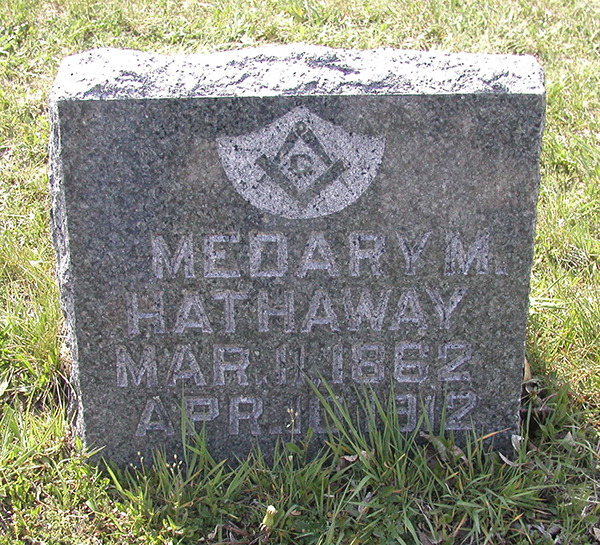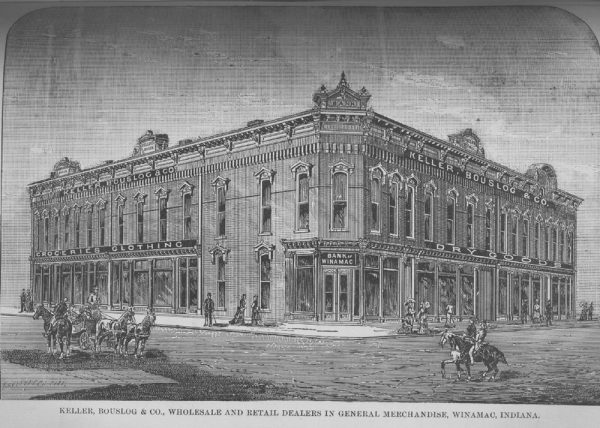
An act as simple as glancing at a street sign can be the key to a wealth of knowledge. This story began as I passed through Winamac last week on my way to Monterey. Going west of U.S. 35 on S.R. 14, the second street is named Hathaway. As I drove past, I wondered how the street got its name. While it’s not clear for whom in particular the street is named, it is almost certainly one of the members of the pioneer Hathaway family.
The Hathaway family’s story is an archetype, of histories shared by many families of their immigration to America and later migrations westwards. The stories began with arrival in the Colonies in the 1700s. After the Revolution came migration into the Northwest Territory, where settlement began with the opening of Ohio in 1788. Later, families moved again, to places even further west.
The first stop for the Hathaways, who came from Wales, was in Virginia, in the 1700s. In the early 1800s a number of family members moved west, settling near Troy, Ohio. The focal family in this story is that of Abraham Jr. and Bathsheba Coe Hathaway. Abraham died in a tree-felling accident near Troy, in 1842. Soon thereafter, his widow and many other family members migrated to this area. Here are a few of their stories.
Carter D. Hathaway (1820-?) was the fifth child of Abraham and Bathsheba. He was a surveyor, claims agent, lawyer, judge, newspaperman, and entrepreneur. He seemed to be everywhere at once. He got a land patent in Cass county in 1848. He platted Knox, the Starke County seat, in 1850. He was charged with laying out the Winamac cemetery in 1846, and was a Pulaski county judge in the 1850s. In 1852, he surveyed and platted the new town of “Medary Ville,” and drew an ornate map (in county Deed Record C, page 263). He and his son Richard Medary owned the Rochester Standard for several years around the time of the Civil War. The paper is still published, under its original name, the Sentinel. At the same time he owned the paper, he registered for the draft and was paying taxes in Oronoko Berrien county, Michigan, near the southeast shore of Lake Michigan. The last mention of him that I found was the 1870 census, when he was in Knox. There is no record of his death or burial.
 Medary Montez “Mont” Hathaway (1862-1912) was the son of Carter’s oldest brother Richard. He was the subject of a long biography in the 1899 Biographical history of Tippecanoe, White, Jasper, Newton, Benton, Warren and Pulaski counties, Indiana.
Medary Montez “Mont” Hathaway (1862-1912) was the son of Carter’s oldest brother Richard. He was the subject of a long biography in the 1899 Biographical history of Tippecanoe, White, Jasper, Newton, Benton, Warren and Pulaski counties, Indiana.
He spent his entire life in Winamac, beginning his career at age sixteen as the teacher of the Walters school. He then worked under the tutelage of Winamac’s first superintendent of schools, Professor Shull.
In 1880 he left teaching to supervise the construction, at age eighteen, of the large “Keller Block,” a grandiose spectacle of a building that still proudly stands in downtown Winamac.
 He next worked in the Auditor’s office, at the same time studying law with Winamac lawyer John C. Nye. In 1890 he was admitted to the Pulaski county bar, and opened a law office. He was also heavily involved in local and state politics, and was a committed member of the Masonic lodge. He is buried, with other family members, including his father and grandmother Bathsheba, in Winamac cemetery.
He next worked in the Auditor’s office, at the same time studying law with Winamac lawyer John C. Nye. In 1890 he was admitted to the Pulaski county bar, and opened a law office. He was also heavily involved in local and state politics, and was a committed member of the Masonic lodge. He is buried, with other family members, including his father and grandmother Bathsheba, in Winamac cemetery.
 Abraham T. Hathaway (1836-1878) was the son of Ebenezer, Abraham’s brother who farmed near Francesville. He married Eliza Jane, daughter of Medaryville farmer and businessman Walling Williams. He took up farming in Cass township just northeast of Medaryville, where he, like his father’s brother, met an accidental death in the woods. He is buried in Sutton cemetery, Cass township. Battey’s 1883 history of the county reports the accident in some detail:
Abraham T. Hathaway (1836-1878) was the son of Ebenezer, Abraham’s brother who farmed near Francesville. He married Eliza Jane, daughter of Medaryville farmer and businessman Walling Williams. He took up farming in Cass township just northeast of Medaryville, where he, like his father’s brother, met an accidental death in the woods. He is buried in Sutton cemetery, Cass township. Battey’s 1883 history of the county reports the accident in some detail:Fatal Accident
So far as could be ascertained, but one fatal accident ever occurred in Cass Township, and that resulted in the instant death of Abraham T. Hathaway. It occurred on or about the 18th day of February, 1878, in the following manner: He had been husking corn during the day, and, in returning to the house in the evening, saw a pheasant not far off. He told the boys to put the team away, and that he would get the gun and kill the pheasant. He got the gun, went to the woods where he had seen the pheasant, and in a short time a shot was heard. The family supposed, of course, that he had shot at the pheasant; but as the dusk of evening soon came on, and he still did not return home, they became uneasy, and went to the woods to look for him ; where, to their great consternation, they soon found him weltering in his blood, and entirely lifeless. The entire charge of shot had taken effect in the right temple, and it is supposed that death ensued instantaneously. It was just in the edge of the woods that they found him. The underbrush was quite thick, and it is supposed that he was bending forward and creeping under the low brushes, with the breach of his gun far back, and that the hammer caught on something, and that just as he turned his head to look back at it, the hammer came down, causing the cap to explode. He had no financial or domestic troubles, and the idea that he committed suicide is not at all entertained by those who knew him and his circumstances well.
Many other members of the Hathaway family played significant roles in the early economic, civic, and political institutions of the area. Even though the large family leaves many descendants, I wasn’t able to find a definitive family history, nor reliable genealogical information.